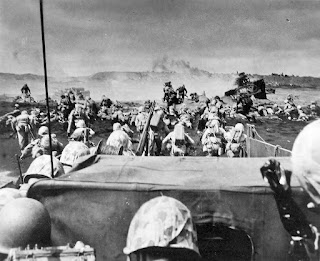A recent document unearthed by staff at the Butler University
Irwin Library’s Special Collections, Rare Books, and University Archives has shaken that belief. Found by Evan N. Miller, library
associate, and brought to my attention by Megan McKee (my wife, who works part
time in the archives), the letter is dated August 21, 1918, from a young man,
Ernest Pyle, from Dana, Indiana, and establishes that at one time Pyle was
interested in attending the college, then located in the Indianapolis
neighborhood of Irvington. Could Pyle—the quintessential IU Hoosier—have
instead gone down in history as a Bulldog?
Addressed to “President, Butler College,”
Pyle’s letter appears to seek further information on a bulletin he had recently
seen about the Student Army Training Corps (the United States had entered World
War I in April 1917). The SATC had been created by the War Department’s
Committee on Education and Special Training to “utilize the executive and
teaching personnel and the physical equipment of the educational institutions
to assist in the training of our new armies,” and training camps had been
established in the summer of 1918 to induct students that fall. The Corps had
two sections: the Collegiate or “A” section and the Vocational or “B” section. The
students were inducted into the service, were subject to military orders, and
received pay. “The housing, subsistence and instruction of soldiers” in both
branches of the SATC, according to a bulletin for the program, was provided by
the educational institutions under contract with the government.
Officially inaugurated on October
1, 1918, the SATC had units at more than 500 educational institutions across
the country and inducted 200,000 students on its first day of existence.
Nineteen colleges and universities in Indiana (Butler, DePauw University,
Hanover College, Huntington College, Purdue University, the University of NotreDame, Wabash College, and Valparaiso University, among others) had SATC units.
In advance of the SATC’s start,
Butler, in late September, announced that construction work had begun on three
barracks to house students enrolled in the program. According to an article in
the September 25, 1918, Indianapolis News, the buildings were to be
built on college ground south of University Avenue between Ohmer and Butler
Avenues, and were to be “double width. They will have stone foundations and
ample heating facilities.” The article went on to say that although the
original limit of 250 students had been passed, the quota could be increased to
300. “Places for surplus students will be found elsewhere by the government,”
the News added. (It appears that 264 men were part of the Butler SATC by
the time it ended.)
Pyle, who had graduated from Bono
High School in May 1918, had badly wanted to do his part for his country. His
best friend, Thad Hooker, about a year older than him, had volunteered for the
army before graduation. At the commencement ceremony Pyle noted that “there was
an empty flag-draped chair on the stage for him [Hooker]. I could hardly bear
to go to commencement, I was so ashamed that I wasn’t in the Army too.”
In his August 1918 letter to
Butler’s president, Pyle sought more information about the SATC, wondering if
one already had “to be a college student to enlist in this Corps, or can a High
School graduate, who intends entering college this fall enlist. What courses
are offered. I would want to take engineering. What are the physical
requirements. I am physically sound except a little light for my height. What
are the terms, and length of semesters. I will come to Indianapolis next week
and enlist in this Corps, and make arrangements for entering your fall term, if
all the desired information is satisfactory.”
Pyle must not been happy with the
answers he received, for in October 1918 he enlisted in the U.S. Naval Reserve
and went off to the University of Illinois to receive his preliminary
training. Before he could be sent off for training at the Great Lakes Naval Training Station in Chicago, however, the war ended with the signing of the
Armistice on November 11, 1918. According to Pyle scholar Owen Johnson, a
retired IU journalism professor, on July 31, 1919, Pyle wrote a letter to IU
officials indicating his wish to enter the university as a student that fall and
seeking information on how to do so. IU responded, Pyle enrolled, and the famed
war reporter’s ties to the school were firmly established.
Butler’s SATC unit received its
orders to demobilize on November 26, with most of the men enrolled released
from their service the first week in December. The unit had its share of
problems, according to Indiana historian Christopher B. Coleman. Writing in the
1919 Butler Alumnal Quarterly, he noted that the unit lacked proper equipment
of all kind. “Though badly handicapped by the lack of equipment,” Coleman
wrote, “the men made considerable progress in knowledge of military life and
tactics.” Unfortunately, they lacked a proper supply of officers to guide them
in their training. “For more than a week of a most critical period in the
organization of the unit,” Coleman pointed out, “one man had to shoulder the
entire burden of the command of the unit—a thing beyond the capacity, probably,
of any man in the service.”
The 1918 worldwide influenza
pandemic, which led to more than 600,000 deaths in the United States alone,
also effected the Butler SATC. Coleman wrote that a hospital “hastily
improvised on Ritter avenue, under the direction of Dr. Walter F. Kelly, was on
several occasions filled to capacity.” Coleman added that one of the most
popular and promising men of the Corps, Wilson Russell Mercer, died at the
hospital due to “an attack of influenza and pneumonia.”




